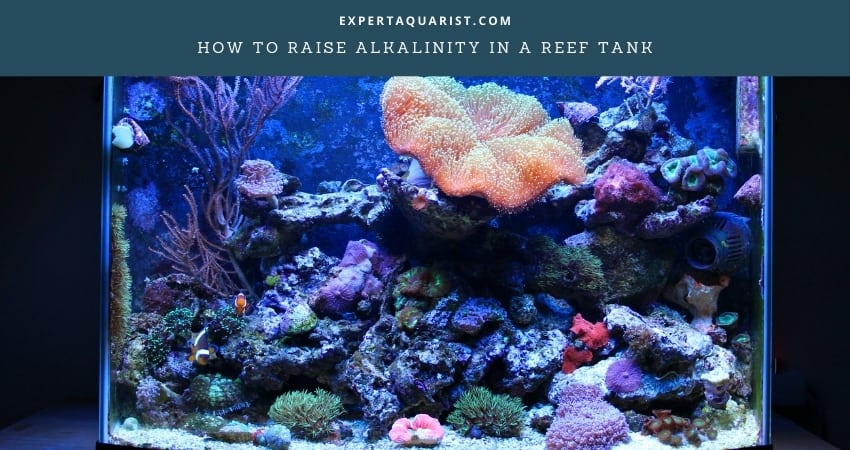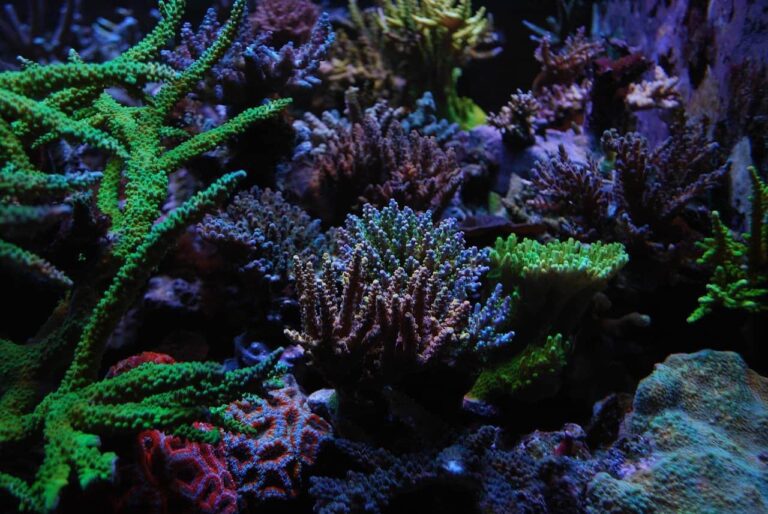In saltwater tanks like reef tanks, everything is connected. So, when the alkalinity of the tank goes down, it affects everything else in the tank. That is why it is mandatory to raise the alkalinity in case it goes down below a certain level.
The most commonly used method of raising alkalinity is to add baking soda to the tank water. You can also use soda ash, lime water, or other mixtures that can be found in various aquarium shops.
Now let’s take a look at how to raise alkalinity in a reef tank. While we are at it, we will also learn how you can measure the alkalinity yourself.
What are the methods of raising alkalinity in a reef tank?
Once the alkalinity level goes down below 8 dKH, you have to immediately take steps to raise it. Luckily for you, there are a few methods of raising alkalinity that you can choose from.

1. Adding Baking Soda
This is one of the most popular and common methods used to raise the alkalinity in a tank. But they have to be used in a manner that doesn’t raise the alkalinity over 1.4 dKH per day. The recommended amount is to add one teaspoon of baking soda for every 10 gallons of water.
2. Adding Soda Ash
This is also one of the best options to raise the alkalinity level. They are easily available at various aquarium shops as well as online. While adding soda ash, remember to follow the instructions properly. If you add too much of it in a short time, it can cause things like tissue loss. You may also see coral bleaching in your tank.
3. Adding Lime Water
Lime water is an excellent choice for balancing the alkalinity as well as the calcium levels. It reduces the water’s free carbon dioxide amount. This in turn drives the pH level up while also buffering the pH.
4. Adding Carbon Dioxide reactors
Another good way to balance calcium and alkalinity levels is to add carbon dioxide reactors. Presence of Carbon dioxide makes the water acidic. These reactors react with the carbon dioxide in the water and increase the alkalinity. A very good example of such reactor media is calcium carbonate.
Additional Read: Best Aquarium Media Reactors
5. Adding Sea Shells
Seashells are one of the best sources of calcium and magnesium. Adding them to your reef tank will only work towards raising the alkalinity. The ideal measurement of adding seashells is 2 pounds per 10 gallons of water. Although this measurement is subjected to the type of the tank and how it reacts to seashells.
6. Adding Supplements
You can also buy various supplements from your nearby aquarium stores. There are 2 part supplements available for both alkalinity and calcium, like B-ionic and C-balance. You can also use sodium bicarbonate along with calcium chloride. You only have to make sure that you add them in the right proportions.
What do you mean by alkalinity?
Before we get to the solution of the problem, first we have to know what alkalinity is. The total alkalinity of a tank is the sum of all the bases in the tank. The capacity of buffering of the tank water is controlled by this alkalinity. Buffering means the ability of a substance to neutralize acids. It also controls the pH level of the water.
The most common sort of base found in reef tanks is carbonate. This is also the most important. You can also find other bases like bicarbonate and hydroxide in your tank.
What is the ideal level of Alkalinity in a reef tank?
Usually, the unit of measuring alkalinity in water is either mg/L (milligrams per liter) or ppm ( parts per million). But when measuring alkalinity in aquariums, the term dKH (degrees of carbonate hardness) is used. 1 dKH is equal to 17.9 mg/L or 17.9 ppm.
The ideal alkalinity range for reef tanks is 8 to 12 dKH. Usually, the reefs have dKH levels of 8 to 9 but don’t worry if the levels reach 12 dKH.
If the levels drop below 8 dKH, then it is time for you to start thinking about how to raise alkalinity in your reef tank.
Read Next: Saltwater Reef Tank Parameters
What makes the alkalinity level of a reef tank drop?
There are three reasons due to which your tank’s alkalinity level may drop. First, the corals present in the tank naturally consume the bases in the water. So you need to regularly replenish their amount. Second, the increase of calcium decreases the alkalinity level in your tank. So if you somehow add more calcium than necessary, you may notice a reduction in the alkalinity levels. Third, while changing the water in the tank, sometimes the newer water may contain a lower level of alkali, so the alkalinity level will drop.
Additional Read: How to lower alkalinity of reef tank
How to keep the alkalinity stable in a tank?
When you are performing the regular care routine you usually do, introduce a few practices in it. This will help in keeping the alkalinity stable in your tank.
Mainly a 2 part solution of alkalinity and calcium is used by most tank owners to stabilize their system. You can find these solutions in your local retail shops. They can play a big part in keeping the alkalinity stable. While you are starting, try to start from the minimum recommended amounts. Take 10 minutes between every part.
Wait for a whole day before testing the system after adding both doses. After that, you can decide whether or not to add any more of the solution.
How can you test alkalinity in a reef tank?
Every method of raising alkalinity will be rendered null and void if you do not know what the alkalinity levels are in the first place. To know the levels of alkalinity, first, you must know how to measure them. You can try one of the following methods.
a. Using Test Strips
This is the easiest way to measure the alkalinity level of your tank. Although the method of testing may vary according to the manufacturing companies, there is a basic way to do it.
Take a strip and partly dip it in the tank. After keeping it submerged for 10 seconds, let the reagents in the strip work with the water by keeping it still. After that, you will get some colors on the strip. These colors are the indicators of the level of alkalinity in the tank. The manuals of the strip should say what color denotes what levels of alkalinity. If not, check the container. Sometimes you may not get the exact color, in which case you have to use common sense.
b. Using Test Kits
There are also some test kits available in the local retailers which you can use to measure the alkalinity of the tank.
To test the water with kits, first, you have to fill a test tube with the water from the reef tank. Then mix reagents with this water and wait a few minutes. Once these reagents are completely mixed, you will see some kind of color in the test tube which will indicate the level of alkalinity in the tank.
Test kits are more accurate than test strips. But you don’t always need the exact amount of alkalinity to treat your water.
Additional Resource: Best Reef Aquarium Test Kit
Importance of testing the alkalinity levels
You must regulate the alkalinity levels of your tank to ensure the safety of the marine animals in it. Alkalinity is very important for the skeleton formation of the corals as well as their calcification. It is crucial to test the alkalinity levels at least once a week.
What is the importance of alkalinity in a reef tank?
You must keep the alkalinity levels in your reef tanks stable. Because :
- A proper and stable level of alkalinity helps in skeleton formation and calcification of corals.
- Coral bleaching, pH swings, or loss of tissue can be prevented by maintaining a stable alkalinity level.
- The equipment in the tank performs better if a proper alkalinity level is maintained.
Can high alkalinity cause problems in a reef tank?
You will face serious problems if high levels of alkalinity are persistent in your reef tank. The main problems you will face due to this are alkalinity burns, high levels of pH, and a drop in the levels of calcium. Proper steps must be taken promptly if high alkalinity levels are noticed.
How does the change in daytime affect the alkalinity level?
Throughout the whole day, the level of alkalinity will change. This will happen as the corals in your tank continue to consume alkali. Their consumption rate also depends on what time of the day it is and hence is inconsistent.
What things should you remember when you raise alkalinity levels in a reef tank?
You can not indiscriminately apply things to your reef tank to raise alkalinity levels. There are a few things you must keep in mind.
- The manufacturing companies don’t usually take imbalances into account when recommending the quantity of the mixture to be added. They merely suggest the amount needed to keep the balance in your tank. So, you will have to add much more mixture than is said in the containers or manuals.
- When using calcium and alkalinity additives on their own, be very careful not to create an imbalance between them. First experiment with smaller amounts to get a picture of the correct amount of additives you have to add to the water.
- If you add 1 tablespoon of baking soda to 10 gallons of water, the dKH levels will go up by 1 point. So ensure that you are slowly adding it to the water, not all at once.
- Sometimes the alkalinity level will continue to be low even after adding a huge amount of supplements. This happens when the magnesium levels in the tank are low. This low level of magnesium prevents the supplements from working properly. So make sure to take steps to increase the level of magnesium.
- Don’t get overwhelmed by the low levels of alkalinity and add too much of it. Too much alkalinity will create severe problems for your corals such as coral bleaching etc. They can also cause the equipment to work inefficiently
Final words
The health and safety of the animals in the reef tank are paramount for any tank owner. One of the first steps towards ensuring this is to regularly monitor the alkalinity levels of the tank. Neither too much nor too little alkalinity levels are healthy for your pond. Follow the above-mentioned steps correctly so that the levels of alkalinity remain stable.






